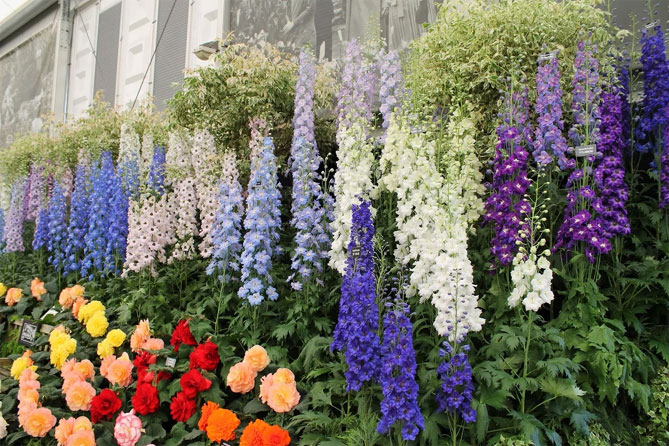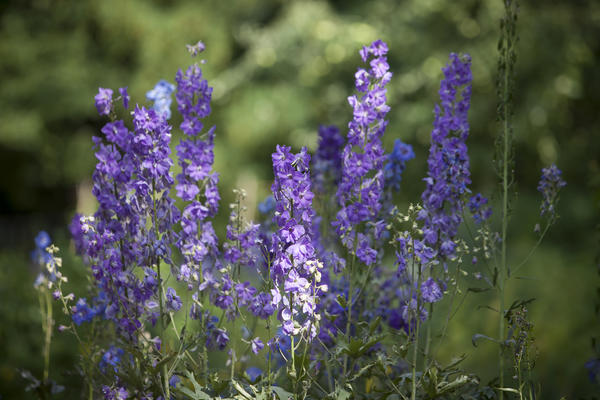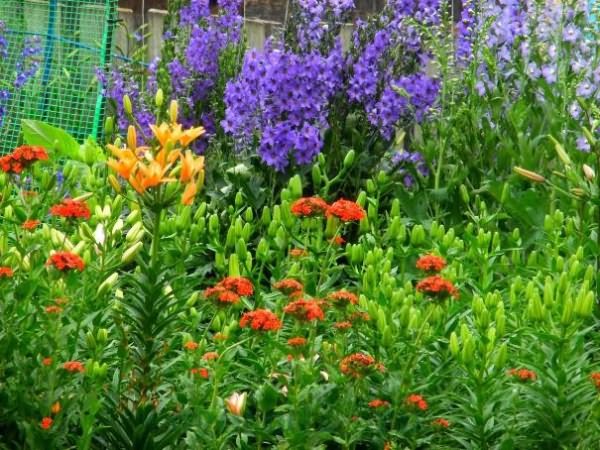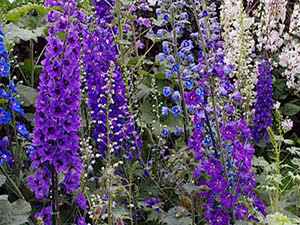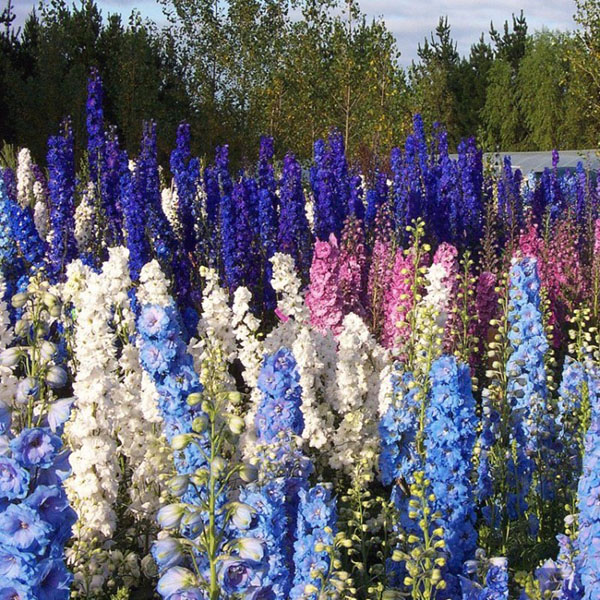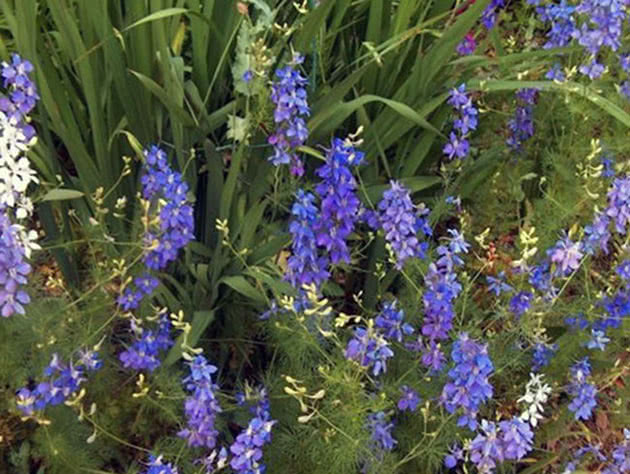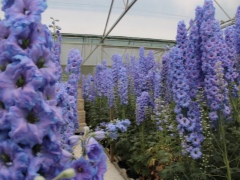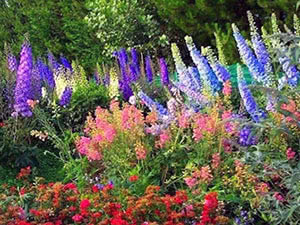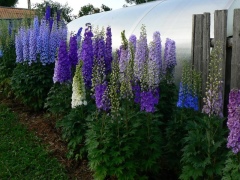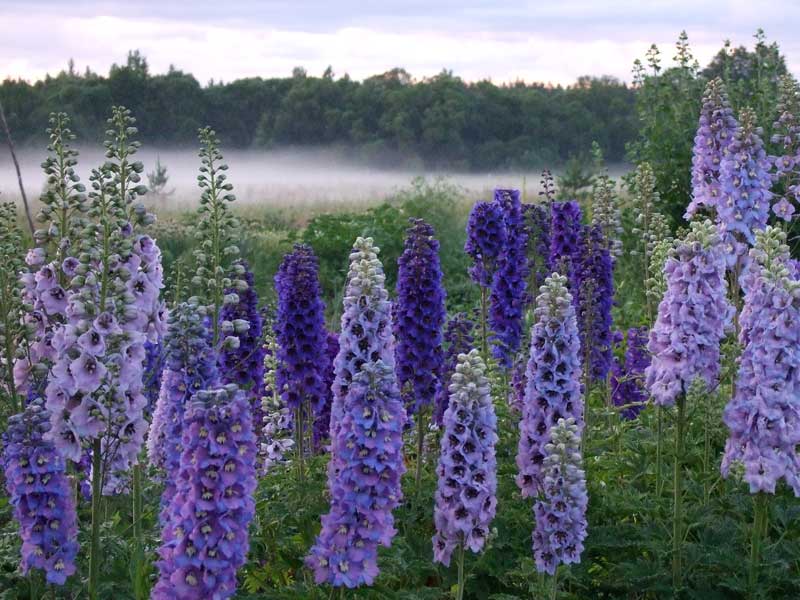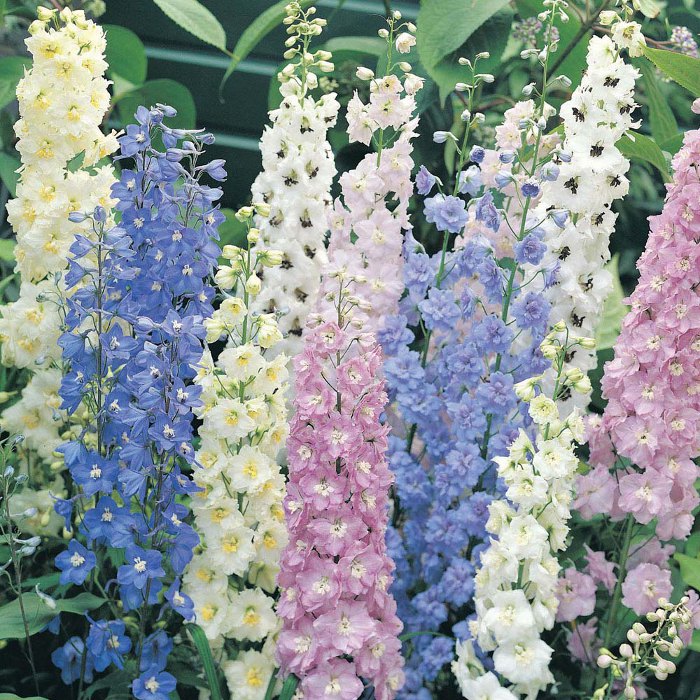Types and varieties of delphinium
It is possible to divide the representatives of the spur genus into 3 groups:
- The highest - the highest delphinium grows up to 3 meters. The leaf plates have a rich green color, the stem is covered with villi. Inflorescences are racemose, dense;
- Large-flowered - represented by an annual plant up to 0.8 m in height. The stem is branched vertically. The delphinium begins to bloom in the middle of summer;
- Field - also belong to annuals, height - up to 2 meters. The flowering period is July-September. Inflorescences are pyramidal, there are both double and simple flowers.
It is worth talking in more detail about some interesting varieties of larkspur.
Delphinium white
Lovers of perennial plants should take a closer look at the Galahard variety. Distinctive features include tallness (about 2 meters) and the presence of snow-white double flowers up to 7 cm in diameter. The inflorescence is cone-shaped.

White variety
The plant is used in the design of borders and walls. Delphinium white stands very well in the cut.
Delphinium yellow
This shade is characteristic of the semi-bred delphinium that grows in Iran and Afghanistan, it is not hybrid. By the height of the plant reaches 120 cm. For those who want to grow a beautiful flower, it is recommended to purchase the seed material of the "Sun Knight". Here it is worth considering the feature that the yellow delphinium possesses - it is a huge thermophilicity.
Delphinium blue
You can meet such a representative in the Caucasus region. This perennial is also called beautiful delphinium. Plant height - up to 0.8 m, inflorescences up to 0.45 m long, racemose shape. The flowers can be either blue or purple.

Blue variety
Delphinium blue is represented by at least two more varieties and varieties: large-flowered or Chinese, "Tsarskoe", "Magic fountain", "Pacific".
Delphinium blue
Called Summer Sky, the variety will delight those plant lovers looking to grow light blue flowers. The height of the spur reaches 2 meters. Perennial crops prefer areas with good light and some shade during hot hours.
Delphinium blue begins to bloom in June and ends in July. Plants can be planted either singly or in groups. Another feature is the long standing cut. This includes the New Zealand delphinium.
Delphinium terry
Several varieties belong to this variety, but the "Black Knight" will look most effective. The culture reaches 2 meters in height, the inflorescences are long, conical, the color of the flowers is purple, closer to lilac. In a flower garden, such a plant looks great with other representatives of perennial families.

Black Knight
Delphinium terry is represented by the following varieties:
- "Black Knight";
- The Guardian;
- "Purple Flame".
Delphinium pink
You can find the pink variety by purchasing the following varieties:
- Princess Caroline;
- "Red Giant";
- Dusky Maiden;
- Deep Sweethearts;
- "The pledge of youth".

Princess Caroline
Delphinium pink "Pledge of youth" is represented by plants reaching a height of 0.7 meters, flowers are pinkish in color. All other varieties are also pink in various saturations.
Perennial delphinium: feeding
During the entire growing season, delphiniums are fed three times.
The first feeding is carried out in early spring, when the shoots have reached 15-20 cm in height: per 1 sq.m. you will need 10-15 g of ammonium nitrate, 20-30 g of potassium chloride and 30-40 g of ammonium sulfate. Fertilizers are mixed and scattered around the delphinium bushes.Instead of these fertilizers, you can use mullein infusion (1:10) as a source of nitrogen - 1 bucket per 5 adult bushes. During the formation of buds, plants need potassium, but the nitrogen content should be reduced.
With the second feeding for 1 sq. m of soil, the doses of superphosphate and potassium are doubled in comparison with the first application. For the third time (at the end or after flowering), only phosphorus-potassium fertilizers with microelements without nitrogen are applied under the bush bushes.
Diseases and pests
Very often the flowers are sick with powdery mildew. The disease is fungal in nature. The symptom is a light coating that then turns brown
It is important to regularly carefully examine the culture and take action at the first alarm signals. Treatment consists in spraying with "Fundazol", also effective means "Topaz"
If the gardener noticed black spots on the stems going up from the bottom, then we can conclude about another common disease - this is how black spot appears. In the initial stages the treatment is successful. Damaged plants are sprayed with tetracycline solution. Take 1 tablet for 1 liter of water.


Sometimes the culture is attacked by insects. The fight against slugs and delphinium flies is carried out with the help of insecticides. The first are also scared off by bleach (containers with it are placed next to the flowers).
Aphids can be a carrier of a dangerous virus. When the culture is damaged, annular spotting appears. The foliage turns yellow and falls off. If such a nuisance occurs, it will not be possible to cope with it. To prevent damage to other plants, the infected specimens are destroyed.

How to care for a delphinium, see below.
Delphinium New Zealand is often called a spur in everyday life. This unpretentious plant will not cause trouble: both an experienced and a novice gardener can grow it. Inflorescences can vary in type and be double, semi-double or simple. Their diameter is often 9-10 cm. Multi-colored and original New Zealand delphiniums will decorate the suburban area.
Perennial delphinium: pests and diseases
Delphiniums are especially strongly affected by various diseases under unfavorable weather conditions: prolonged rains, prolonged drought. Therefore, the fight against pests and pathogens begins at the first sign of their appearance.
Powdery mildew is the top priority in terms of prevalence. It progresses rapidly at high humidity and low air temperatures. Its signs are a mealy whitish bloom on the leaves, which later turns brown. To combat this disease, plants are sprayed with fungicidal preparations (copper sulfate, colloidal sulfur, Fundazol, ProfitGold, Topaz, Fitosporin-M).
Another common disease of fungal etiology is ramulariasis. It is characterized by the appearance of a large number of brown spots on the leaves of the delphinium.
Manifestation of ramulariasis on delphinium leaves
With the further development of the disease, the spots become light gray with a dark rim along the edges and merge, forming extensive necrotic areas on the foliage. As a result, the leaves die off prematurely, the plant is inhibited. Spores of the pathogen overwinter on plant debris, so they must be collected and burned.
If various black spots have appeared on the shrubs, then these are signs of a bacterial disease - black spot. Spots are formed first on the lower tiers of leaves, gradually "rising" up the plant. The stalks of the larkspur turn brown and dry out.
Black spot on the lower leaves of the delphinium
Early treatment will help save the plant. It is sprayed three times with copper-containing preparations: Oxyhom, Bordeaux liquid, Previkur, Fundazol, Topaz. Between treatments, the soil under the bushes can be shed with a solution of Fitosporin-M, and the ground part of the plant with Baikal-M.
Of the viral diseases on the delphinium, ring spot is often found, which looks like yellowish spots in the form of irregular rings. The leaves become chlorotic.
Ring-spotted delphinium leaf
This disease cannot be treated, so the diseased plant is removed and burned. Aphid is the carrier of ring spot. To combat it, insecticides are used (Iskra, Fitoverm, Inta-vir, karbofos, biotlin, etc.).
Another malicious pest of this culture is the delphinium fly, which lays eggs in the buds. After hatching, the larvae spoil the flowers, feeding on stamens and pistils. Damaged flowers fall off prematurely and do not bear fruit.
As a result of the parasitism of the delphinium (sporn) mite, swellings appear on the leaves of the plant, they are deformed and die off. The delphinium acquires a "curly" appearance, no inflorescences are formed on it, growth stops.
Seedlings and juicy young shoots of delphinium are severely damaged by slugs and snails. To combat them, traps are used, mechanical barriers are arranged around the beds, and granular metaldehyde is used from chemical preparations.
Reproduction of delphinium
There are several breeding options for a home burgundy.
Cuttings
Plants are cut in the spring, after the young shoots have grown. As soon as they reach a height of 10 cm, they can be cut off at the very root with a small particle of it. The cuttings are planted in a suitable container with soil, deepening the root by 2 cm. The ideal temperature regime in the room is + 20-25 ° С.
Helpful advice. Larkspur cuttings root best in light soil of equal proportions of peat and sand.
It is not recommended to put the stalk in a very sunny place, it is best to choose light shade. A glass or polyethylene shelter is used to create a greenhouse-like environment. After 14-21 days, the roots of the system begin to grow. The process takes 28-35 days.
Growing from seeds
This method assumes 2 options: the seeds are sown directly into the ground, or seedlings are first obtained from them, then the seedlings are transplanted to the site.
How to get seedlings
You can achieve flowering in the first year of a perennial's life by following the following scheme:
- Sowing is carried out in February (in the presence of phytolamps for additional illumination) or you need to wait until daylight hours increase.
- The seeds are processed before planting.
- The choice of capacity for sowing also matters. It is recommended to use shallow seedling containers with drainage holes.
- Soil preparation. You can use a universal seedling mixture or for succulents. For those who want to make it with their own hands: 2 parts of peat, 4 parts of garden or garden soil, 2 parts of humus or compost, 1 part of sand. Sift the soil, add perlite at the rate of 1 glass per 10 liters of soil.
- The soil is disinfected (heating in the oven for 60 minutes). If the mixture is purchased, then it must be spilled with "Fitosporin".
- Fill containers with soil, sow material over the surface, deepen and press down.
- For dusting, vermiculite or a little potting soil is used.
- Cover the containers with lids or plastic, put the crops in a dark, cool place. There they will begin to grow.
An important point. Using peat pots for delphinium seeds is not suitable. The roots of seedlings reclaim the land slowly, which leads to acidification of the soil.
Seeds begin to germinate in the middle of the 2nd week. It is recommended to carry out daily checks of seedlings from 7 days (after planting). As soon as the crops appear, they will need to be transferred to a warmer room. Shelters are also removed.
Delphinium flowers are obtained from seedlings under the following conditions:
- wet soil;
- daylight hours 12-14 hours;
- temperature + 18-20 ° С.

Seedling
A pick is carried out when 2 real leaves appear.The sprouts need to be placed in individual small cups, the soil is suitable the same that was used for germination, you also need to add a complex mineral fertilizer at the rate of 2 tablespoons per 10 liters of soil.
On a note. Before planting plants in a permanent place, it is recommended to feed them with a suitable complex mineral fertilizer. If the solution gets on the leaves of the delphinium, it must be washed off.
Landing in the garden
You need to plant a delphinium flower in the second half of April, you need to start by preparing the garden:
- dig up the soil 30 cm;
- make top dressing of a complex type;
- make grooves to a depth of 1.5 cm;
- make abundant watering;
- spread the seed along the grooves;
- cover with dry soil.
To obtain faster and more friendly seedlings, the garden bed is closed to create a greenhouse effect using agrofibre or dark film. The beds need to be moistened periodically so that they do not dry out. You can remove the material after the shoots appear in 21-28 days.
By dividing the bush
You need to choose shrubs that have reached 3-4 years of age. Spring is best for reproduction, when leaves begin to grow.

Dividing the bush
It is necessary to extract the root from the soil and divide so that each delenka has one shoot, one dormant bud and many roots. The disembarkation is carried out at a prepared place.
CARE
In order for the larkspur to constantly bloom and grow well, you need to follow the simple rules for caring for plants:
- Feeding with cow dung: for 5 bushes, 10 buckets of water and one bucket of manure. Shoots should grow up to 15 centimeters.
- Loosen the beds and remove weeds.
- The soil is mulched with peat and humus (3 cm).
- When the spurs reach 30 centimeters in height, the plants are thinned out, leaving up to 5 stems in one bush. The inflorescences will be large and lush. Weak shoots are cut off near the ground. Healthy petioles serve as planting material when pruned.
- With a growth of 50 centimeters, the delphinium is tied up. Support rods up to 180 cm are carefully placed and bushes and supports are tied with fabric strips, a strong wind should not break the flowers. As the plant grows, the bushes are tied up again.
- Every week, during the dry season, 2 buckets of water are consumed per bush. During flowering, watering is required, otherwise gaps in the inflorescence will appear.
- Fertilized with potassium and phosphorus additives. For one plant - a bucket of water with 20 g of fertilizer. This is done in the fall and spring.

